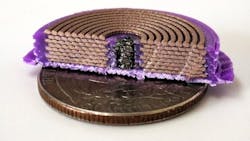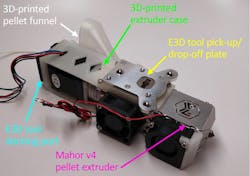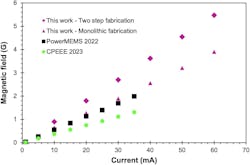3D-Printed Electromagnet Yields Powerful Solenoid
What you’ll learn:
- Why 3D-printed solenoids are needed and viable.
- How an MIT team devised an innovative approach to printing these solenoids.
- Details of the comparative performance results of their approach.
Like its cousin the transformer, the solenoid is a basic electromagnetic component. It’s built using three different materials: a dielectric material that serves as an insulator, a conductive material that forms the electric coil, and a soft magnetic material that makes up the core. The ability to build them as needed would simplify the supply and replacement chain as well as ease the fabrication of one-off custom versions.
To achieve this, a research team at MIT’s Microsystems Technology Laboratories (MTL) modified a multimaterial additive-manufacturing (3D) printer so that it could print compact, magnetic-cored solenoids in one step (Fig. 1). Although this isn’t the first reported 3D-printed solenoid, their version developed a magnetic field that was about 3X the intensity of the largest fields previously reported from 3D-printed solenoids.
Powerful Solenoid Built via Extrusion Printing
Extrusion printing builds objects one layer at a time by “squirting” feedstock material through a nozzle. Typically, a printer uses one type of material feedstock, often spools of filament.
“Some people in the field look down on them because they are simple and don’t have a lot of bells and whistles, but extrusion is one of very few methods that allows you to do multimaterial, monolithic printing,” noted Luis Fernando Velásquez-García, a principal research scientist on the project.
To achieve their result, the project team had to overcome many materials and processing obstacles, as making a solenoid involves coiling thin layers made from multiple materials that may not be compatible within a single machine.
The solenoids are produced by precisely layering three different materials: a dielectric material (pure PLA) that serves as an insulator, a conductive material that forms the electric coil (PLA doped with copper particles), and a soft magnetic material that makes up the core (nylon or PLA doped with metallic particles) (Fig. 2). (Note: Polylactic acid, or PLA, is a thermoplastic material commonly used in additive manufacturing.)
The 3D-Printer Arrangement
To achieve their goals, the team selected a printer with four nozzles; one nozzle was dedicated to each material to prevent cross-contamination. They chose the E3D Motion System and ToolChanger from E3D-Online, Chalgrove, Oxfordshire, UK (Fig. 3). They needed four extruders rather than just three because they tried two soft-magnetic materials, one based on a biodegradable thermoplastic and the other based on nylon.
They retrofitted the printer whereby one nozzle could extrude pellets rather than filament. That’s because soft magnetic nylon, which is made from a pliable polymer studded with metallic microparticles, is virtually impossible to produce as a filament. Yet this nylon material offers far better performance than filament-based alternatives.
Using the conductive material also posed challenges, since it would start melting and jam the nozzle. The researchers found that adding ventilation to cool the material prevented it from happening. They also built a new spool holder for the conductive filament that was closer to the nozzle, reducing friction that could damage the thin strands (Fig. 4).
Precisely controlling the process is of extreme importance because each material prints at a different temperature. Depositing one on top of another at the wrong time might cause the materials to smear. Their printing method enabled them to build a three-dimensional device comprising eight layers, with coils of conductive and insulating material stacked around the core like a spiral staircase. Multiple layers increase the number of coils in the solenoid, which improves the intensity of the magnetic field.
Solenoid Test Results Characterize Performance
The modified hardware printed a solenoid the size of a U.S. quarter (diameter of one inch/25 mm) as a spiral by layering material around the soft magnetic core, with thicker conductive layers separated by thin insulating layers. Because their machine could print with a more effective soft magnetic material, the solenoids achieved higher performance than other 3D-printed devices.
Due to the added precision of the modified printer, they could make solenoids that were about 33% smaller than other 3D-printed versions. More coils in a smaller area also boosts intensity.
To evaluate performance, the team built a system to measure the magnetic field using a setup consisting of an axial gaussmeter, a nonmagnetic positioning stage, a Mu-metal magnetic-shielding chamber, and a custom 3D-printed support structure fabricated in undoped PLA.
The magnetic fields were measured approximately half a millimeter away from the center of the top conductive layer of the solenoids while applying a DC current. Their solenoid developed a magnetic field that was about 3X larger than what other 3D-printed devices had achieved at a given current level (Fig. 5).
The work is detailed in a lengthy, very readable paper, “Three-dimensional, soft magnetic-cored solenoids via multi-material extrusion,” published in Virtual and Physical Prototyping. Their paper is especially insightful and informative because it doesn’t just tell the “we did this and then that, and then ended up here” story. Instead, it also clearly discusses the problems they encountered and how they overcame or worked around them, in a true engineering discussion.
About the Author

Bill Schweber
Contributing Editor
Bill Schweber is an electronics engineer who has written three textbooks on electronic communications systems, as well as hundreds of technical articles, opinion columns, and product features. In past roles, he worked as a technical website manager for multiple topic-specific sites for EE Times, as well as both the Executive Editor and Analog Editor at EDN.
At Analog Devices Inc., Bill was in marketing communications (public relations). As a result, he has been on both sides of the technical PR function, presenting company products, stories, and messages to the media and also as the recipient of these.
Prior to the MarCom role at Analog, Bill was associate editor of their respected technical journal and worked in their product marketing and applications engineering groups. Before those roles, he was at Instron Corp., doing hands-on analog- and power-circuit design and systems integration for materials-testing machine controls.
Bill has an MSEE (Univ. of Mass) and BSEE (Columbia Univ.), is a Registered Professional Engineer, and holds an Advanced Class amateur radio license. He has also planned, written, and presented online courses on a variety of engineering topics, including MOSFET basics, ADC selection, and driving LEDs.





